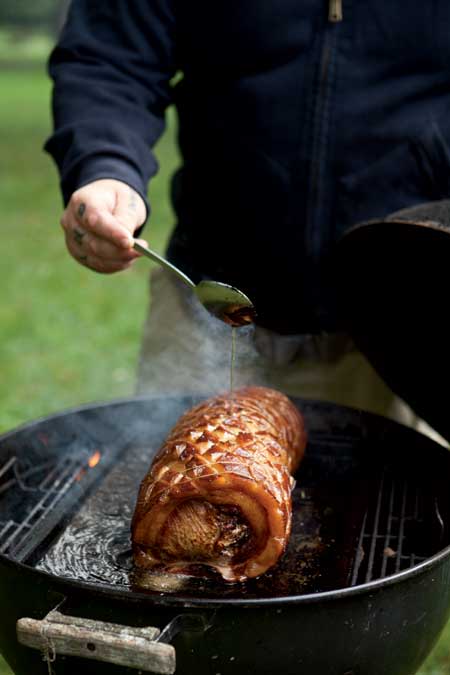Grill-Roasted Pork Shoulder with Sage, Rosemary & Thyme
Roast this pork shoulder–rolled around an herb paste of sage, rosemary, thyme, lemon, and garlic–slowly on the grill, giving it an extra hit of smoky flavor by tossing in handfuls of applewood chips.

Coffee By Design | Portland, Maine
Photo Credit : Katherine KeenanMatt likes to roast this pork shoulder–rolled around an herb paste of sage, rosemary, thyme, lemon, and garlic–slowly on the grill, giving it an extra hit of smoky flavor by tossing in handfuls of applewood chips. If you have the setup and the inclination, it’s a great way to cook. However, we’ve also roasted the meat in a standard oven, and we find that the seasonings alone make it wonderfully flavorful. You’ll find instructions for both methods (including those for cooking on a gas grill) below.
Yield:
8 to 10 servingsIngredients
1 cup sweet wood chips, such as apple or cherry (optional)
20 fresh sage leaves
3 sprigs fresh thyme, leaves removed
3 sprigs rosemary, leaves removed
4 medium-size garlic cloves, peeled and roughly chopped
2 tablespoons fresh lemon zest
2 tablespoons olive oil
1 3-4 pound skin-on boneless pork shoulder, butterflied to even 1-inch thickness (see note)
1 tablespoon kosher or sea salt, plus more to taste
1-1/2 teaspoons freshly ground black pepper, plus more to taste
2 large Spanish or white onions, roughly chopped
1-1/2 cups dry white wine, such as Pinot Grigio, plus more as needed
1/2 cup water
Instructions
If you’re cooking on the grill, first soak the wood chips in water for at least 30 minutes. Meanwhile, in a food processor, combine the sage, thyme, rosemary, garlic, lemon zest, and olive oil. Pulse just until the mixture becomes a chunky paste. Unroll the pork and season on both sides with 1 tablespoon of salt and 1-1/2 teaspoons of pepper; then rub all over with the herb-and-garlic mixture.
Let the meat sit 25 minutes while you prepare the grill for indirect heat: If you’re using a charcoal grill, pour about 80 briquettes into a chimney starter and light it. When the briquettes are coated with ash, pour them onto the bottom grate, banking them to one side; then replace the top grate. If you’re using a gas grill, set the burners on one side of the grill to medium-high; leave the others off. If you’re using your oven, preheat it to 350°.
Meanwhile, turn the pork so that one of the long sides is facing you. Starting from the bottom, carefully roll the meat, jellyroll style, into a compact package. Using butcher’s twine, tie the roll crosswise every inch or so to create a uniform thickness.
Scatter the onions in the bottom of a small foil roasting pan. (If cooking in your oven, use a regular roasting pan.) Place the pork on top of the onions, and pour the wine into the pan.
When the grill (or oven) is hot, get ready to cook the pork. If you’re using a charcoal grill, throw the wood chips directly onto the coals. If you’re using a gas grill, put the chips into the smoker box. If you’re using your oven, forget the chips.
Set the pan containing the pork on the cool side of the grill. If you’re using your oven, put the pan on the second-to-bottom rack. Cook the pork–adding more wine to the bottom of the pan as needed to keep it wet–until the internal temperature is between 140° and 145° (the meat will continue to cook after it comes off the heat). Cooking time will vary from grill to grill and with the type of fuel you’re using, but estimate 2 to 2-1/2 hours. If you’re using a charcoal grill, you’ll need to add an extra handful of charcoal to the fire every 30 minutes or so.
Remove the pork to a serving platter and cover with foil to keep it warm. Deglaze the roasting pan with 1/2 cup of water, and strain juices into a small pan. Skim off the fat, and season to taste with salt and pepper. Slice the pork, arrange on a platter, and drizzle with the pan juices.







